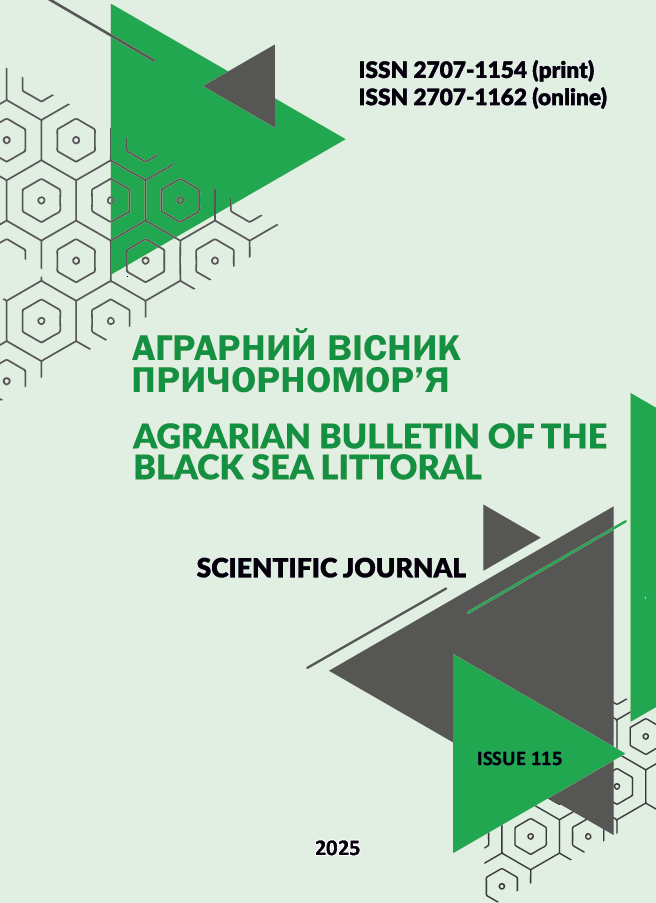COMPREHENSIVE ASSESSMENT OF THE INFLUENCE OF STARTER CULTURES AND CASINGS ON THE QUALITY OF "ZOLOTYSTA" SALAMI
DOI:
https://doi.org/10.37000/abbsl.2025.115.12Keywords:
technology, dry-cured sausage, starter cultures, sausage casings, organoleptic properties, physicochemical properties, food safetyAbstract
In modern sausage production, starter bacterial cultures are widely used to enable targeted control of the fermentation process, accelerate technological procedures, and obtain high-quality products. The aim of this study was to determine the impact of various starter cultures and types of sausage casings on a range of technologically significant quality indicators in the production of dry-cured salami «Zolotysta». The research was conducted at the premises of individual entrepreneur V.G. Kolesnik, trademark «Ovidopolski Sausages». To study and research the peculiarities of the technology for producing Zolotysta salami dry-cured sausage, the main minced meat, prepared according to the recipe, was divided into four equal parts by weight, and further technological processes were carried out in accordance with the characteristics and recommendations for the use of specific starter cultures and casings. The research showed that the use of the Bactoflavor SafePro® Flora Italia LC starter culture allows for a shorter maturation period and improves the taste, color, and texture of the sausages. Although BioSTART Plus 50 slows the process, it promotes faster meat batter tightening, more active pH reduction, and consistent ripening. The collagen casing Fabios demonstrated better physical-mechanical and hygienic properties, while the polymer casing NaloFerm, despite extending the maturation time, had a positive effect on appearance, shape stability, and aromatic characteristics of the product. The best organoleptic scores were observed in samples made with the combination of Bactoflavor SafePro® Flora Italia LC and NaloFerm casing. BioSTART Plus 50 led to a more intense reduction in moisture and acidity, whereas Bactoflavor SafePro® Flora Italia LC ensured stable pH levels and contributed to a milder flavor profile. The highest microbiological activity and concentration of lactic acid bacteria were found in samples from groups I and III, indicating the effective action of Bactoflavor SafePro® Flora Italia LC. In contrast, samples from groups II and IV showed lower microbiological values, likely due to the use of BioSTART Plus 50 or the NaloFerm casing, which may partially suppress microbial development.
References
Kyshenko I.I., Topchii O.A., Kryzhova Yu.P., Rybachuk O.I. Startovi kultury dlia fermentatsii syrokopchenykh kovbas. Kharchova nauka i tekhnolohiia. 2014. №. 3. S. 23–26. [in Ukrainian].
Laranjo M., Potes M.E., Elias M. Role of starter cultures on the safety of fermented meat products. Front Microbiol.2019. Vol. 10. P. 853. https://doi.org/10.3389/fmicb.2019.00853.
Chen Q., Kong B., Han Q., Xia X., Xu L. The role of bacterial fermentation in lipolysis and lipid oxidation in Harbin dry sausages and its flavour development.LWT-Food Sci.Technol. 2017. Vol. 77. P. 389–396. https://doi.org/10.1016/j.lwt.2016.11.075.
Hu Y., Li Y., Li X., Zhang H., Chen Q., Kong B. Application of lactic acid bacteria for improving the quality of reduced-salt dry fermented sausage: Texture, color, and flavor profiles. LWT-Food Sci Technol. 2022. Vol. 154. P. 112723. https://doi.org/10.1016/j.lwt.2021.112723.
Jung Y. S., Yoon H. H. Quantitative descriptive analysis and consumer acceptance of commercial dry fermented sausages. J East Asian Soc Diet Life.2020. Vol. 30. P. 306–315. https://doi.org/10.17495/easdl.2020.8.30.4.306.
Shynkaruk M., Baluk O. Perspektyvni startovi kultury dlia kraftovykh kovbasnykh vyrobiv. Tavriiskyi naukovyi visnyk. Seriia: Tekhnichni nauky. 2021. №5. S. 38–48. https://doi.org/10.32851/tnv-tech.2021.5.6 [in Ukrainian].
Jungeun Hwang, Yujin Kim,Yeongeun Seo, Miseon Sung, Jei Oh, Yohan Yoon. Effect of Starter Cultures on Quality of Fermented Sausages. Food Science of Animal Resources. 2023. Vol. 43(1). P. 1–9. https://doi.org/10.5851/kosfa.2022.e75.
Sirini N, Munekata PES, Lorenzo JM, Stegmayer MÁ, Pateiro M, Pérez-Álvarez JÁ, Sepúlveda N, Sosa-Morales ME, Teixeira A, Fernández-López J, Frizzo L, Rosmini M. Development of healthier and functional dry fermented sausages: Present and future. Foods. 2022. 11:1128. https://www.mdpi.com/2304-8158/11/8/1128.
Doeun D., Davaatseren M., Chung MS. 2017. Biogenic amines in foods. Food Sci Biotechnol. 2017. 26:1463-1474. https://pubmed.ncbi.nlm.nih.gov/30263683.
Özogul F, Hamed I. 2018. The importance of lactic acid bacteria for the prevention of bacterial growth and their biogenic amines formation: A review. Crit Rev Food Sci Nutr 58:1660-1670. https://pubmed.ncbi.nlm.nih.gov/28128651.
Kryzhak L.M., Semko T.V., Ivanishcheva O.A. Doslidzhennia osoblyvostei vykorystannia shtamiv probiotykiv u tekhnolohii vyrobnytstva fermentovanykh miasnykh produktiv. Naukovyi visnyk Tavriiskoho derzhavnoho ahrotekhnolohichnoho universytetu. Melitopol: TDATU, 2023. Vyp. 13, tom 1. S. 242–251. https://ir.vtei.edu.ua/g.php?fname=28680.pdf [in Ukrainian].
Kryzhak L. Kovbasy kraftovi syrovialeni z dodavanniam chervonoho sukhoho vina. Mizhnarodnyi naukovo-praktychnyi zhurnal Tovary ta rynky. 2024. Vyp. 50, t. 2. S. 110–120. https://doi.org/10.31617/2.2024(50)08 [in Ukrainian]
Downloads
Published
How to Cite
Issue
Section
License

This work is licensed under a Creative Commons Attribution-NonCommercial 4.0 International License.


